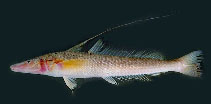| Family: |
Sillaginidae (Smelt-whitings) |
| Max. size: |
44 cm TL (male/unsexed) |
| Environment: |
demersal; freshwater; brackish; marine, amphidromous |
| Distribution: |
Western Indian Ocean: Pondicherry northward along the Coromandel coast, Ganges delta, Myanmar, southward to Malaysia and rarely to the Indonesian Archipelago. |
| Diagnosis: |
Dorsal spines (total): 11-11; Dorsal soft rays (total): 25-27; Anal spines: 2-2; Anal soft rays: 24-27; Vertebrae: 42. The head is greatly depressed; the eyes are very small. Second dorsal spine very elongate. |
| Biology: |
Found in shallow, open muddy bays and estuaries (Ref. 4833). Feed on fish, crustaceans and algae. Spawn twice a year during the months of November to February and August to September and the juveniles migrate toward the upper reaches during March and April and during December where they remain for 2 to 3 months. Sexually mature upon reaching a length of 12 cm (Ref. 6205). Oviparous (Ref. 205). |
| IUCN Red List Status: |
Not Evaluated (N.E.) Ref. (130435)
|
| Threat to humans: |
harmless |
Source and more info: www.fishbase.org. For personal, classroom, and other internal use only. Not for publication.

